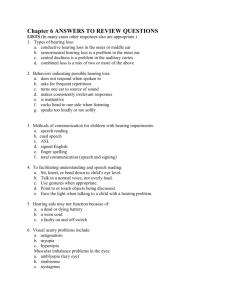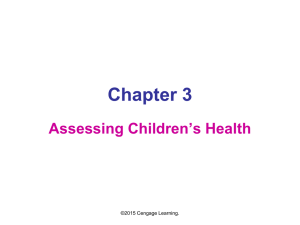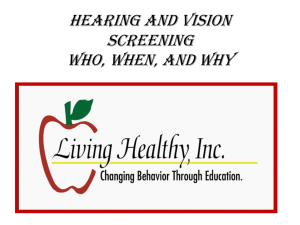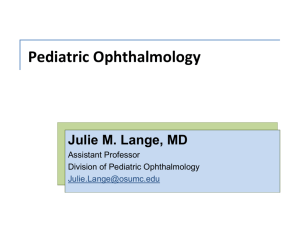chapter 4 health assessment tools
advertisement
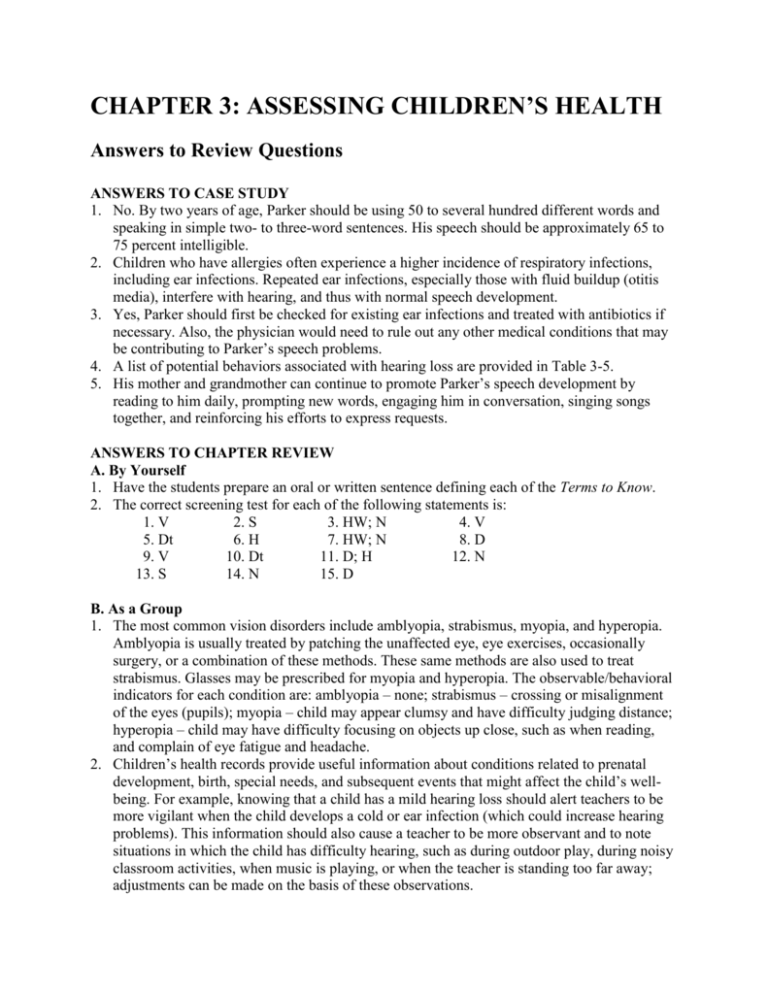
CHAPTER 3: ASSESSING CHILDREN’S HEALTH Answers to Review Questions ANSWERS TO CASE STUDY 1. No. By two years of age, Parker should be using 50 to several hundred different words and speaking in simple two- to three-word sentences. His speech should be approximately 65 to 75 percent intelligible. 2. Children who have allergies often experience a higher incidence of respiratory infections, including ear infections. Repeated ear infections, especially those with fluid buildup (otitis media), interfere with hearing, and thus with normal speech development. 3. Yes, Parker should first be checked for existing ear infections and treated with antibiotics if necessary. Also, the physician would need to rule out any other medical conditions that may be contributing to Parker’s speech problems. 4. A list of potential behaviors associated with hearing loss are provided in Table 3-5. 5. His mother and grandmother can continue to promote Parker’s speech development by reading to him daily, prompting new words, engaging him in conversation, singing songs together, and reinforcing his efforts to express requests. ANSWERS TO CHAPTER REVIEW A. By Yourself 1. Have the students prepare an oral or written sentence defining each of the Terms to Know. 2. The correct screening test for each of the following statements is: 1. V 2. S 3. HW; N 4. V 5. Dt 6. H 7. HW; N 8. D 9. V 10. Dt 11. D; H 12. N 13. S 14. N 15. D B. As a Group 1. The most common vision disorders include amblyopia, strabismus, myopia, and hyperopia. Amblyopia is usually treated by patching the unaffected eye, eye exercises, occasionally surgery, or a combination of these methods. These same methods are also used to treat strabismus. Glasses may be prescribed for myopia and hyperopia. The observable/behavioral indicators for each condition are: amblyopia – none; strabismus – crossing or misalignment of the eyes (pupils); myopia – child may appear clumsy and have difficulty judging distance; hyperopia – child may have difficulty focusing on objects up close, such as when reading, and complain of eye fatigue and headache. 2. Children’s health records provide useful information about conditions related to prenatal development, birth, special needs, and subsequent events that might affect the child’s wellbeing. For example, knowing that a child has a mild hearing loss should alert teachers to be more vigilant when the child develops a cold or ear infection (which could increase hearing problems). This information should also cause a teacher to be more observant and to note situations in which the child has difficulty hearing, such as during outdoor play, during noisy classroom activities, when music is playing, or when the teacher is standing too far away; adjustments can be made on the basis of these observations. 3. This activity can easily be adapted for children with sensory deficits. For example, the “seeing” activity can be modified for a child who is blind: the teacher names (aloud) and has the child feel each object as he/she spreads them out on the floor. When it is the child’s turn to guess which item is missing, he/she can come up and feel the remaining objects to identify the one that is missing. To modify this activity for a child with a hearing loss, instructions should be explained in a manner of communication (e.g., gestures, demonstration, sign language, simple words, louder voice) that allows the child to understand. 4. There are many ways teachers can incorporate physical activity into the school day. Physical activities can be built into math, science, and reading learning experiences. Periods of planned and spontaneous outdoor play should be included everyday. Teachers can set up games and team competitions (indoor and outdoor) centered around hula hoops, hopping on one foot, skipping, jumping rope, running between barriers, catching and throwing balls, etc. Walks centered on a specific theme (how many colors can we find, what birds do you see, what sounds do you hear) are also an effective way to engage children in physical activity. Brief five minute breaks can also be taken during which children participate in stretching exercises, jumping jacks, or a quick run around the playground. Older children need frequent activity breaks as well and should not be made to sit for longer than 2 hours at a time. 5. BMI calculations offer a reliable tool for evaluating a child’s height/weight ratio. If this information is presented to families in a constructive and educational manner, it can be useful for improving the child’s short- and long-term well-being. Rather than informing a parent that their child is overweight or obese, teachers can provide information about healthy eating habits, resources for low-fat/low recipes, suggestions for increasing physical activity as a family, etc. If this approach is taken, no child or family will feel singled out since these behavioral changes can have positive outcomes for everyone. 6. Hearing tests are often available through community screening clinics, medical centers, child development programs, public health departments, private health care professionals, public schools, and Head Start programs. Check the local telephone directory to locate these services.
